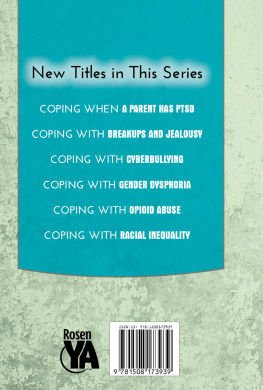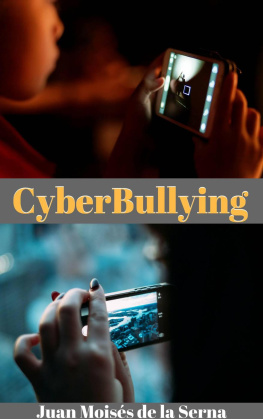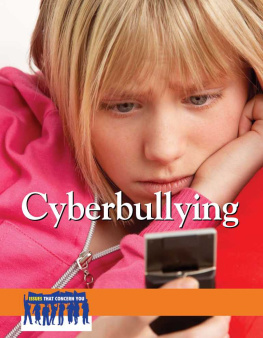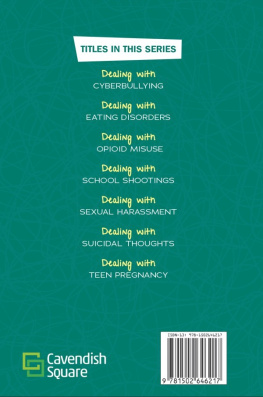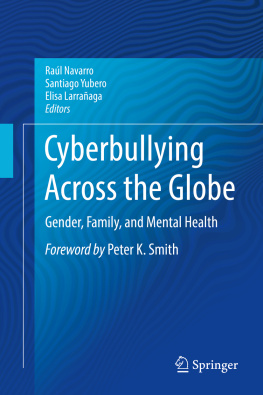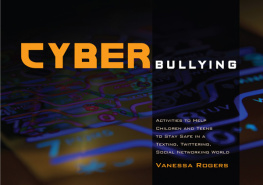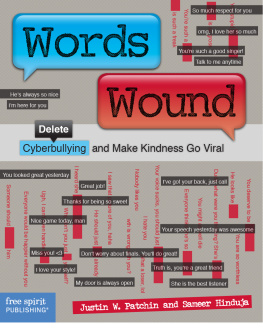Published in 2018 by The Rosen Publishing Group, Inc.
29 East 21st Street, New York, NY 10010
Copyright 2018 by The Rosen Publishing Group, Inc.
First Edition
All rights reserved. No part of this book may be reproduced in any form without permission in writing from the publisher, except by a reviewer.
Library of Congress Cataloging-in-Publication Data
Names: Mapua, Jeff, author.
Title: Coping with cyberbullying / Jeff Mapua.
Description: First Edition. | New York, New York: Rosen Publishing, 2018. | Series: Coping | Audience: Grades 912. | Includes bibliographical references and index.
Identifiers: LCCN 2016059973 | ISBN 9781508173939 (library bound)
Subjects: LCSH: CyberbullyingJuvenile literature. | CyberbullyingPrevention Juvenile literature.
Classification: LCC HV6773.15.C92 M337 2018 | DDC 302.34/302854678dc23
LC record available at https://lccn.loc.gov/2016059973
Manufactured in the United States of America
CONTENTS
Introduction
CHAPTER ONE
A Digital Age Issue
CHAPTER TWO
Identifying a Problem
CHAPTER THREE
Pushing Back on Cyberbullying
CHAPTER FOUR
Seeking Help
CHAPTER FIVE
Prevention and Treatment
CHAPTER SIX
Bouncing Back
GLOSSARY
FOR MORE INFORMATION
FOR FURTHER READING
BIBLIOGRAPHY
INDEX
INTRODUCTION
C ell phones, tablets, laptops, wearable devices, and other electronics are all around us nowadays. People can connect with one another at a moments notice, any time of the day or night. A new generation is growing up having never known a life before the internet. Digital lives and reputations are taken seriously, as seriously as IRL (in real life). However, along with the enhanced ability to communicate online come the negative aspects of social life and the ugly side of human behavior.
Many are familiar with bullying in the traditional sense. A bully at school, for example, will tease or threaten someone they see as weak or defenseless. The threats can intensify and even lead to physical violence. Though a serious concern in the days before everyone lived online, bullies could only torment those physically in their presence. Cyberbullying, on the other hand, can happen any hour of the day, on any day of the week, regardless of whether someone is at school, at home, or anywhere. It takes place over the Internet, via cell phones, smartphones, computers, tablets, and other devices.
Cyberbullies can use popular social media sites, text messaging, online chats, and any number of websites as tools of harassment. They are the culprits behind mean texts, threatening emails, and hurtful rumors that circulate via social media. Other forms of harassment include sharing embarrassing photos or videos online using one of the many image-sharing applications teens use in their daily lives. There have also been cases where cyberbullies create fake profiles and personas online with the sole intention of bullying their victims.
Because it is easy to hide ones true identity online, vicious posts can be made anonymously. This anonymity makes it difficult to find out who is responsible for a threatening or embarrassing post. Worse still, a post, message, image, or video online can reach a wide audience extremely quickly. Distributing content over the Internet is a simple click away, and a victim can see a rumor spread like wildfire. As many have had to learn the hard way, taking down a message online is extremely difficult once it has been posted.
Not all cyberbullies restrict their abusive behavior to the online world. Cyberbullying is associated with bullying in person, and vice versa. The worst part for victims is that physically removing oneself from a live bullying situation is no longer a surefire way to stop abuse.
What can be done about this, and how can you cope? It is not easy, but there are many strategies to prevent, deal with, and even do away with cyberbullying on a case-by-case basis. There are even movements by school communities lately to rally around victims. Coping with cyberbullying is a new frontier of modern life.
Because teenagers often have their mobile devices nearby, cyberbullying can occur at any time of the day. This can mean a seemingly endless cycle of daily and nightly abuse.
CHAPTER ONE
A Digital Age Issue
A ccording to a report released in 2015 by the Pew Research Center, 92 percent of teens say they go online every day. The study reported that 24 percent of teens, defined by this study as those from the ages of thirteen to seventeen, go online almost constantly. Overall, 56 percent of teens go online multiple times a day, compared to 12 percent who say they go online just once a day. Only 6 percent say they go online just once a week. The catalyst for the constant online connection is the availability of smartphones.
Pews research showed that nearly 75 percent of teens either own or have access to a smartphone, while only 12 percent say they do not have a mobile device of any type. The research also showed that 91 percent of teens use their mobile devices to go online at least occasionally, and nearly all of these teens go online at least once a day. The numbers show that teens who do not go online using a mobile device go online less frequently overall.
Research shows that the vast majority of teens have access to the Internet every day via different electronic devices. For all intents and purposes, a big chunk of teens nowadays live online.
Where do all of them flock to online? The study revealed that Facebook, Instagram, and Snapchat are the top social media platforms for teens. Facebook reigns supreme with 71 percent of teens claiming they use the site, while about 50 percent are on Instagram, and 40 percent on Snapchat. But even with these high usage rates, teens are not locked into just one social media platform. In the study, 71 percent report using multiple outlets, including Google+, Twitter, Tumblr, and more.
Social conventions and interactions have changed over the last twenty years, and defining cyberbullying is a modern exercise. Exactly what kind of behaviors count as cyberbullying? Aside from it happening online or via phone or smartphone, what defines cyberbullying? The first step in addressing the problem is identifying it in the first place.
Exclusion
According to social psychologists, the desire to feel included is a basic human need. In a teens world, this often translates to being popular, or at least not terribly unpopular. Exclusion can be one of the most painful experiences for young people.
Psychologists have pointed out that, for teens, being accepted and included is an important aspect of social life. All is right with the world if someone makes you feel worthwhile on social media.
Just as in the nondigital world, online exclusion can be emotionally hurtful. Many social media sites and applications feature an inner-circle aspect such as a friends list or a group of people who are followed. On Facebook, for example, unfriendingor removing someone from ones list of online friends or contacts can have just as much impact as ostracism in the real world. Studies have shown that exclusion leads to lowered self-esteem for those who are left out.

